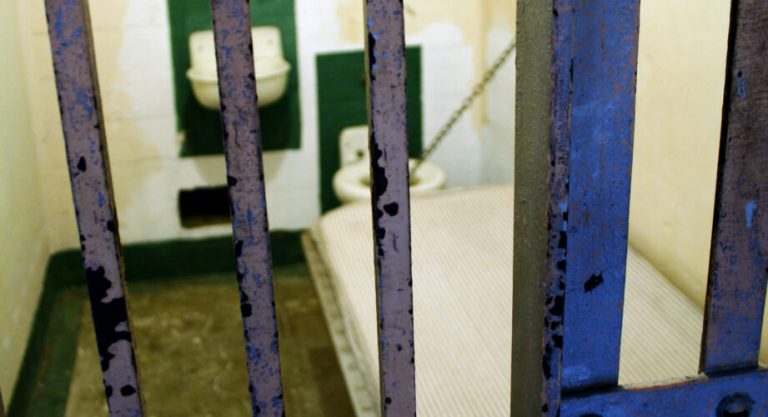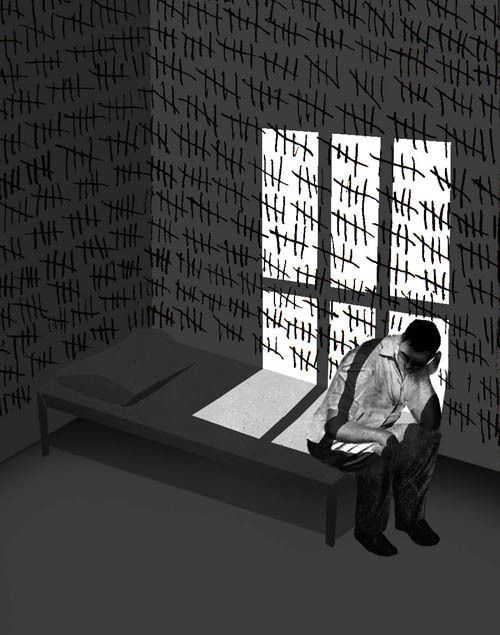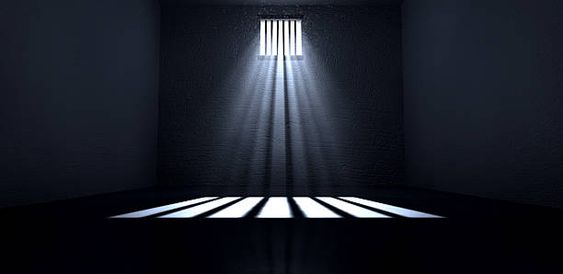
Estimates from academic and other sources suggest that there are tens of thousands of prisoners held in solitary confinement in the U.S.
By Clark Merrefield
Solitary confinement is the practice of keeping a prisoner alone in a cell about the size of a parking space, with minimal human contact and limited access to the outdoors.
Corrections officers and officials remove prisoners from the general prison population and place them in solitary confinement for a variety of reasons.
While there is no centralized, current census on the prevalence of solitary confinement, estimates from academic and other sources suggest that on any given day there are tens of thousands of prisoners held in solitary confinement in the U.S.
What is solitary confinement and why is it used?
Solitary prisoners are typically confined to their small cells for 23 hours a day except for an hour in a rec pen, “an outdoor cage connected to a cell by a door,” writes Matthew Azzano in a 2022 article for The Marshall Project. Federal appeals courts have largely held that prisoners in solitary are entitled to outdoor time.
Furniture is usually minimal — an open toilet, a ledge jutting from the wall with a thin foam mattress for a bed. A solitary cell might also have two cement cubes attached to the wall, “forming an awkward chair and desk of sorts,” writes University of California, Irvine criminologist Keramet Reiter in her 2018 book, “23/7: Pelican Bay Prison and the Rise of Long-Term Solitary Confinement.” Some facilities keep the lights on all day and night in their solitary confinement units.
The practice of holding a prisoner in solitary confinement falls under what is called restrictive housing, which the National Institute of Corrections — an agency of the Federal Bureau of Prisons — defines as “housing some inmates separately from the general population of a correctional institution and imposing restrictions on their movement, behavior, and privileges.”

Thirty-four state prison systems plus the Federal Bureau of Prisons responded to the survey, covering about 61% of the roughly 1.2 million people held in U.S. prisons.
Prison officials rarely use the term “solitary confinement.” This term is more prevalent among journalists and academic researchers. Prison officials tend to favor the term “segregation” — meaning a prisoner is kept away from the general population for days, weeks or years.
A March 2016 report from the National Institute of Justice, which is the research, development and evaluation agency of the U.S. Department of Justice, describes three situations in which prisoners are typically segregated from the general population:
Protective custody is when a prisoner is at risk of being injured by other prisoners.
Disciplinary segregation is when a prisoner breaks prison rules and is punished following a hearing.
Administrative segregation is when a prisoner poses a threat to members of the general prison population.
“Isolation through solitary confinement is prevalent across both administrative and disciplinary segregation,” according to the report.
But prison officials sometimes send prisoners to solitary for other reasons, including in retaliation for speaking up following assaults allegedly committed by guards, according to recent reporting from Alysia Santo and Joseph Neff at The Marshall Project.
Solitary confinement use by the numbers
Two recent analyses indicate the share of U.S. prisoners held in solitary confinement falls somewhere in the range of 3% to 6%.
A national survey of U.S. prison systems conducted by the Arthur Liman Center for Public Interest Law at Yale Law School estimates there were 41,000 to 48,000 people in restrictive housing as of July 2021.
Thirty-four state prison systems plus the Federal Bureau of Prisons responded to the survey, covering about 61% of the roughly 1.2 million people held in U.S. prisons. Across these jurisdictions, a median of about 3% of people were held in restrictive housing. Ten jurisdictions reported leaving the lights on all night in their solitary confinement units.
The survey defines “restrictive housing” as a prisoner being held in an isolation cell for more than 15 days and for 22 hours per day on average. This is the same as the United Nations’ definition of prolonged solitary confinement in its rules on the treatment of prisoners, known as the Nelson Mandela Rules. These rules, adopted by resolution of the General Assembly in December 2015, are not binding — meaning it is up to each country whether and how to implement them.
The Liman Center has conducted the survey every two years since 2013. The survey data are the only ongoing, current national estimates on the use of restrictive housing.
In 2015, the center estimated there were 80,000 to 100,000 prisoners held in restrictive housing. The 2017 survey report estimated 61,000 prisoners held in restrictive housing; the estimate was roughly the same for the 2019 survey report. This reduction of roughly half since 2015 is notable, but there are caveats.
For example, the authors of the 2021 Liman survey report write that “a jurisdiction that held people in isolation for no more than twenty-one hours per day would appear in the Survey data as holding no people in restrictive housing.”
During the early part of the COVID-19 pandemic, 300,000 people were living in lockdown conditions similar to solitary confinement, according to reporting by Keri Blakinger at The Marshall Project. Prison officials increasingly used lockdowns, creating solitary-like conditions with prisoners held in cells for most of the day, to try to curtail the spread of the virus within prison walls.
The authors of the recent Liman Center study note that their most recent survey snapshot, in July 2021, was during a lull in COVID infection rates.
The Liman Center survey does not capture estimates for prisoners held in solitary confinement in local jails. A recent estimate from Solitary Watch, a nonprofit that produces research and reporting on solitary confinement in the U.S., includes local jails but takes a broader definition of solitary confinement — namely, a prisoner being held in an isolated cell for 22 hours on any given day.
Solitary Watch estimates across jails and prisons roughly 122,000 prisoners were held in restrictive housing in mid-2019, according to a 2023 report from the group.

The analysis is based on federal and state data, as well as a survey of local jails conducted by the Vera Institute of Justice. It is the first to cohere estimates of solitary use in both prisons and jails. Roughly 6% of prisoners held in federal prisons and jails, state prisons and local jails are held in solitary confinement at any given time, according to the Solitary Watch analysis.
A recent analysis of prisoner data by NBC News senior reporter Erik Ortiz finds that as of September 2022, there were 11,368 out of 142,000 federal prisoners held in restrictive housing, up 7% from May of that year.
Segregated, isolated housing situations are not limited to prisoners encountering the traditional criminal justice system. Officials at U.S. Immigration and Customs Enforcement detainment facilities can hold noncitizens in conditions similar to solitary confinement — in cells separated from the general population of detainees for up to 24 hours a day, according to a 2022 report from the Government Accountability Office.
The federal government watchdog estimates ICE made 14,581 segregated housing placements from 2017 to 2021. “About 40 percent of these placements were for disciplinary reasons, such as drug possession, and about 60 percent were for administrative reasons, such as protective custody or medical reasons,” according to the report.
The demographics of solitary confinement
A November 2020 report, led by Florida State University criminologist Daniel Mears and funded by the National Institute of Justice, offers insight into who is typically held in solitary using administrative records for 184,183 prisoners in Florida correctional facilities from 2007 to 2015.
Long-term solitary confinement of over six months is more common among prisoners who are younger, Black and male, the report finds. Those held in long-term solitary “also consisted of a higher percentage of individuals who had been incarcerated for violent crimes (54.9% vs. 27.7%), who had been assigned longer sentences (45.6 months vs. 31.6 months), who had been diagnosed with a mental illness (28.9% vs. 15.0%), and who needed mental health services (31.1% vs. 16.6%),” the authors write.
The authors also find high relative rates of Black men born during those years who were held in solitary confinement
Another paper, published November 2021 in Science Advances, analyzes Pennsylvania prison records from 2007 and 2016 and estimates that almost one in five Black men born in the state from 1986 to 1989 had been incarcerated by age 30.
The authors also find high relative rates of Black men born during those years who were held in solitary confinement, which they define as being held in solitary for at least a full day.
“Estimating the population prevalence, we find that 11% of all black men in Pennsylvania, born 1986 to 1989, were incarcerated in solitary confinement by age 32,” the authors write. “Reflecting large racial disparities, the population prevalence is only 3.4% for Latinos and 1.4% for white men. About 9% of black men in the state cohort were held in solitary for more than 15 consecutive days, violating the United Nations standards for minimum treatment of incarcerated people.”
The authors find that this racial disparity is driven less by choices that prison officials make on who ends up in solitary, and much more so by systemic factors — namely, that Black and Latino men are generally at a higher risk of incarceration than white men.
Research also suggests solitary confinement does not usually work to deter future rule breaking — though there may be individual cases in which someone held in solitary for a length of time shows improved behavior upon return to the general population.
One analysis, published January 2019 in Criminal Justice and Behavior, looks at data on more than 9,000 prisoners who spent at least one day in restrictive housing from 2007 to 2010 in a Midwestern prison. The authors, Ryan Labrecque and Paula Smith, find no association between time spent in solitary and later infractions, both violent and nonviolent.
The mental and physical toll
Mental health problems, such as post-traumatic stress disorder, and physical issues, such as musculoskeletal pain and cardiovascular hypertension, are well documented in the academic literature as consequences of long-term solitary confinement.
Research has found those held in solitary are at higher risk for early death
But much of the research on the mental health effects of solitary confinement is based on small samples or is anecdotal, as Columbia University clinical psychologist Elizabeth Ford noted during the John Jay symposium.
“We really don’t know — we do not know — the full impact of what the practice of confining people, who are already confined, has on mental health at any kind of large population level,” Ford said.
Long-term solitary confinement usually falls under the administrative segregation umbrella and can last anywhere from several weeks to years. Research has found those held in solitary are at higher risk for early death.
Prisoners who have spent any time in solitary confinement are 24% more likely to die within the first year after their release from prison, compared with prisoners who never experienced solitary confinement, according to a 2019 study of nearly 230,000 former prisoners in North Carolina, published in the Journal of the American Medical Association.
Those prisoners held in solitary were 78% more likely to die by suicide and 54% more likely to die by homicide within the first year after release — and “127% more likely to die of an opioid overdose in the first 2 weeks after release,” the authors write.
Research also suggests a link between existing mental illness among prisoners and the use of solitary confinement. Prisoners with a serious mental health diagnosis, such as major depression or schizophrenia, are 170% more likely to end up in long-term solitary confinement, according to an analysis, published in 2022 in Justice Quarterly, of more than 155,000 male prisoners who entered correctional facilities in a large southern state from 2007 to 2015.
The Mississippi State Penitentiary in Parchman, the state’s only maximum security prison, is a case in point. Of the 12 prisoners who have died by suicide there since 2019, all were being held in restrictive housing, according to an investigatory report by the U.S. Department of Justice published in April 2022.
Click here to read Full Research Paper
____________
Courtesy: The Journalists’ Resource (Posted on June 6, 2023) Received through email